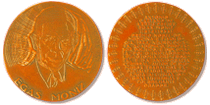


Professor Egas Moniz
Egas Moniz lived in the end of the 19th century, in the period of creation of the fundamentals of specialty he postulated and in which he carried out important researches. Moritz Heinrich Romberg (1795-1873), Guillaume Duchene (1806-1875), Jean Martin Charcot (1825-1893) and John Hughings Jackson founded the modern neurology. Then came the generation of Egas Moniz. This Portuguese scientist improved his studies with them and has the pleasure of presenting his works and scientific findings to them. On the 28th June 1927 was performed the first cerebral angiography in a living man. Egas Moniz founded in this method an information potential in anatomic, physiologic, pathologic and therapeutic orientation terms. He was aware that was a lot of research to be carried out and opted to focus his studies in the cerebral angiography in order to assure a higher knowledge combined with a minor damage for the patient. He had stimulated other Portuguese specialists to apply angiography in other fields, making contributing to the creation of the Portuguese angiographic school: Reinaldo dos Santos, Augusto Lamas e Pereira Caldas implemented and developed the arteriography of the members (1928); Hernâni Monteiro, Álvaro Rodrigues e Sousa Pereira were the precursors of researches on lymphangiography (1930), and Lopo de Carvalho, Almeida de Lima initiated the use of angiopneumography in the study of pulmonary tuberculosis (1931). Up to then, vast bibliography existed about the important role of the frontal lobes in psychic activity, which was a result of the experiments collected in Comparative Anatomy and Clinical Practice. In December 1935 by a process of alcoholization of the oval center of the frontal lobe, Egas Moniz, with the help of Almeida Lima, performed the first prefrontal leucotomy. Later the direct section replaced alcoholisation. In every neuropsychiatric centers this surgeries had a wider acceptance and became more common than the finding and applicability of cerebral angiographies. The scientific works of Egas Moniz, in the scope of mental illness finally got the Nobel Prize of Medicine in 1949. The Faculty of Medicine of Oslo gave him the Oslo award for the finding of central angiography and the subsequent work he developed. The awards decorations and tributes this honorable Portuguese scientist gathered represented the temporal testimony of public recognition for his notable contribution for the progress of Medicine.
